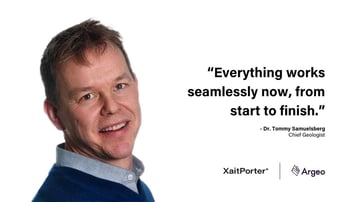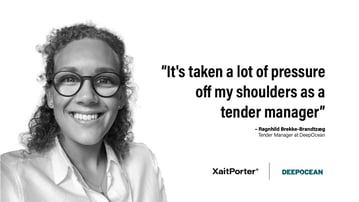Here, you’ll discover proven strategies, practical tips, and actionable insights for efficiently developing proposals that truly resonate with your clients and drive positive outcomes.
Winning proposals
Winning offerings are more than just a document deliverable; they are strategic tools designed to persuade clients to choose your solution over the competitor’s solution.
Whether you are bidding E&R, construction, government, or just about any other competitive industry, winning bids resonate with readers because they are:
- Client-Focused: Demonstrate that you understand them and their situation.
- Benefits-Driven: Showcase your solution’s value through the desired outcomes.
- Evidence-Supported: Highlight client proof of your solution’s benefits.
- Easy-to-Understand: Make it easy to read, navigate and evaluate.
When these elements are combined, they create a document that is informative, persuasive, and effective in driving client engagement and decision-making.
Planning a Winning Proposal
Planning a winning offer is about more than just coordinating experts, tasks and timelines. It’s about positioning your team for the win. By investing time and effort into planning development, you significantly increase your chances of persuading clients over to your way of thinking.
Capture Management Strategy
The capture strategy defines how your business will win a specific contact, project, or opportunity. This includes pre-RFP or Tender research and analysis into the client’s needs, and the competitors strengths and weaknesses. The result is a plan that moves your business from a potential unknown or outlier position to the position of preferred supplier or partner - before the RFP or Tender is released.
Best practice capture management approaches include:
- Begin Early: Identify the opportunity early, about 12 - 24 months before the RFP or Tender, and prepare to research, analyze, and build relationships.
- Understand the Client: Identify their challenges and needs, their pain points and hot buttons, requirements and goals, as well as their fears and objections.
- Investigate the Competition: Evaluate their background and market position, marketing strategy and client base. Conduct a Freedom of Information Act (FOIA) exercise to review similar past responses from key competitors or incumbents. Analyze their value proposition, win themes, and evidence.
- Conduct a SWOT Analysis: Use the tried and true Strengths, Weaknesses, Opportunities, and Threats (SWOT) analysis framework to evaluate your competitor position and develop a strategic capture plan.
By getting involved in the pre-RFP or Tender sales and capture process, managers can proactively influence the direction of the document they will be tasked to develop. This allows them to identify challenges early, gather essential information and resources, and develop an effective win strategy.
Proposal Win Strategy
A targeted win strategy is the cornerstone of effective team development. While it includes resources, tasks and timelines, it also includes key capture details. These details guide your experts in their writing to optimize their time and ensure they deliver the outcomes you expect.
Leverage what you’ve learned from the capture phase to develop the keys to your win strategy:
- Winning Value Propositions make the case for your business as the problem-solver, and are easy to communicate and remember.
- Winning Win Themes resonate with what the client wants and echo your value proposition across the document, making it memorable.
- Winning Differentiators are specialized, relevant, true, and provable, and directly support your value proposition and win themes.
- Winning Discriminators focus on people, experience and performance to demonstrate your understanding of the client’s goals and objectives.
- Winning Proof Points showcase how your solution solved a relevant client problem and achieved measurable results.
By arming your experts and contributors with these strategic components, you empower them to create documents that are more tailored, focused and persuasive. Without major revisions.
How to Write a Winning Proposal
Before asking your contributors to put pen to paper, take time to annotate your outline with the strategic components you defined as part of your win strategy.
By highlighting each section’s key themes, differentiators, discriminators and proof points, you communicate what is expected in the first draft. Add in the section’s specific evaluation criteria and you guide them down a writing path that is more likely to lead to what the client expects and prioritizes.
As they write, they’ll use these guiding details to:
- Hook the reader by opening with an anecdote, question or fact that reminds the reader about the problem they are trying to solve.
- Craft a compelling story that positions the readers as the hero, and weaves in examples and anecdotes that help them see the big picture and connect the dots.
- Demonstrate industry knowledge by echoing your value proposition through your management approach, and how past experiences have shaped it.
- Showcase your track record by highlighting your differentiators through your battle-tested implementation or project approach.
- Empathize with readers by speaking about their concerns, objections and fears and how you overcome them.
- Ghost the competition, without naming them, by showcasing your discriminators through the executive summary and key section introductions.
- Support all claims with evidence that elevates your credibility every step of the way, from executive summary to conclusion.
Suggested content:



How to Strengthen Your Proposal
The first draft is written and it’s right on target. Now you have time to evaluate your content and identify areas where you can strengthen your communication.
A thorough review and revision process can significantly enhance the clarity, persuasiveness and overall impact of your document. Here are some key areas to focus on:
- Review with Vigor: A team of reviewers, armed with your capture and win strategy, bring important perspective. Ask them for instructions, not opinions, to build a roadmap of revisions that enhance value and readability.
- Revise with Focus: Based on the time that remains, prioritize revisions by focusing first on compliance and second on boosting your evaluation score. Add context where concepts are challenging. Add evidence where claims lack proof.
- Bring Clarity and Coherence: Help readers understand and follow-along by keeping it short and relevant. Add visuals to help tell the story and reach different types of readers. Break up long sections with subheadings that drive the story forward.
- Simulate Evaluation: Recruit fresh eyes for an independent review and officially score your response - focus on how to move the evaluation score needle forward on each section.
This step of your development process helps to strengthen your value proposition by ensuring it effectively communicates your message.
Recommended article: Proposal management guide for sales teams
Build a Strong Contributor Team
Assembling a team of skilled experts and contributors who understand the win strategy is just a part of the winning puzzle. To deliver a winning offer, you must also empower this team with tactics and teamwork.
By providing targeted training and fostering a collaborative environment, you can empower your team members to write effectively and efficiently.
- Cultivate Open Communication: Walk through the win strategy together, and invite questions and debate. Bring marketing in to discuss positioning and messaging, and executives to talk about how this project will impact the business.
- Empower Your team: Discuss strategies for creating a compelling and memorable story. Provide on-demand workshops on storytelling and persuasive writing and how to connect with reader’s emotions. Demonstrate the power of data and how it drives decision-making.
- Foster Real-time Collaboration: Centralize your win strategy for easy access and consultation. Centralize your team development so experts and contributors can work together real-time.
Collaborative Power: The Secret Weapon
One of the biggest frustrations experts and contributors have is lack of continuity. They may all be working toward a common goal, but they are still all working individually on siloed sections.
They can’t see who else is working on the larger document and communicate with them. They can’t see what they are writing and connect with it. When it’s time to compile the sections into the document, content is fragmented and disconnected, which means more work for you, reviewers, experts and contributors to fix.
When you knock down those silos, you foster clear communications that keep everyone in sync, no matter where or when they work. They are more efficient and productive, and more likely to hit their deadlines with ease.
- Better Expertise Leveraging: Everyone easily shares their expertise and insights, leading to a stronger and more informative result.
- Enhanced Coherence and Consistency: Everyone ensures a consistent tone, style, and message, as well as accuracy and transitions between sections.
- Greater Visibility into Progress and Status: Meanwhile, management can keep their finger on the pulse of progress, and step in before a bottleneck becomes a delay.
Conclusion
In the competitive world of bidding, a well-crafted, strategic proposal makes all the difference. By carefully planning, thoughtfully executing and fostering team collaboration you can increase your chances of being understood, persuading clients, and securing the projects you desire.
Remember, win strategy and teamwork makes the winning proposal dream work!









